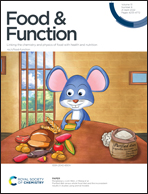Administration of whey protein complexed vitamin D3 to vitamin D3-deficient growing Sprague-Dawley rats
Abstract
Vitamin D deficiency is a global health issue with consequences for bone health. Complexation of vitamin D3 with specific whey proteins might increase the bioavailability and enhance the effect of dietary supplementation on health outcomes. The current rat study was set up to investigate if complexation of vitamin D3 with whey protein isolate (WPI) or β-lactoglobulin (B-LG) increases bioavailability of the vitamin and how it impacts markers of bone turnover and bone structure. For 8 weeks, growing male Sprague Dawley rats (n = 48) were fed a vitamin D-deficient diet and during the final 4 weeks gavage dosing of vitamin D3 either alone (VitD) or complexed with WPI (VitD + WPI) or β-LG (VitD + B-LG) was administered. A placebo treatment (placebo) was also included. After sacrifice, samples of bone were collected and analyzed using biomechanical testing and μCT scanning. The concentrations of vitamin D3, vitamin D3 metabolites and bone markers (P1NP and CTX) were measured in serum. The results showed that VitD + B-LG appeared to induce lower levels of 25-hydroxy vitamin D3 in serum compared to VitD alone. Markers of bone turnover were generally higher in the VitD group compared to placebo and the VitD + WPI and VitD + B-LG treatments. No effects of treatments on bone strength or bone microstructure were detected. In conclusion, whey protein complexation of vitamin D3 supplements appeared to have no beneficial effects on circulating vitamin D3 metabolites but this did not impose changes in bone strength or trabecular bone microstructure.



 Please wait while we load your content...
Please wait while we load your content...